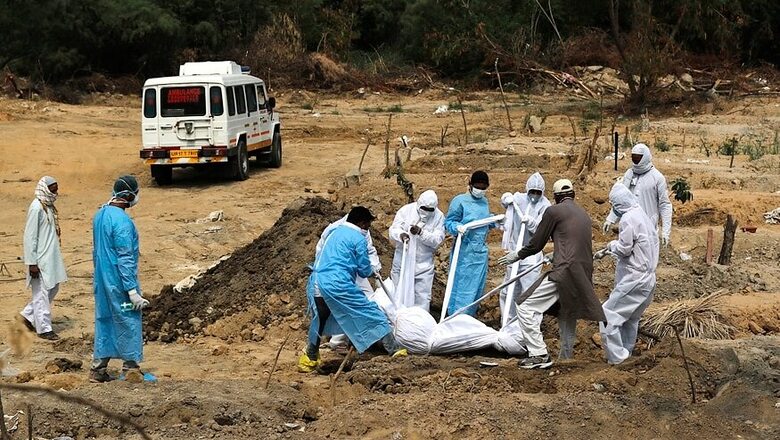
views
On 12 June, the Supreme Court slammed the Delhi government for poor handling of the pandemic. Terming Delhi’s COVID-19 management as “horrendous, horrific and pathetic” where patients are being treated “worse than animals”, the highest court directed the state’s chief secretary and health secretary to submit the status report on the issue immediately.
The Supreme Court’s observations are not without strong basis. With the surge in cases, Delhi has been struggling with limited number of healthcare professionals, availability of hospital beds, critical healthcare support infrastructure and other related resources to contain the outbreak. After recording more than 10,000 cases in the last three days, New Delhi’s tally stood at 70,000 on June 24, surpassing Mumbai in terms of the number of cases.
While Delhi’s recent surge of cases is linked to significant increase in testing, the growth trends of cases in the last fortnight indicates that Delhi may staring at an unprecedented Covid-19 crisis.
Looking at Delhi’s Covid-19 situation as well as the reports that have anticipated bigger surge in days to come, the Centre stepped in to provide the needed support to contain the pandemic. Lieutenant Governor (L-G) Anil Baijal, Union Home Minister Amit Shah and Union Health Minister Harsh Vardhan have convened several meetings and have taken some important steps to control the crisis. The narrative has changed in Delhi since the central government stepped in and took charge from the Aam Aadmi Party (AAP).
Incidentally, a few months ago the Arvind Kejriwal led AAP government had won a landslide re-election in Delhi largely on its stellar performance in health and education. Its famed Mohalla clinics model of expanding primary healthcare among poorest neighbourhoods set an example for the other state governments across the country. It took Ban Ki-moon, former Secretary General of United Nations to commend AAP government’s Mohalla clinics to expand access to healthcare for poor and the needy.
Four months later, the narrative changed. AAP was not only unprepared for the rapidly threatening pandemic, the government was also being accused of hiding data on Covid deaths, going slow on ramping up health infrastructure particularly beds, testing and a host of related decisions to contain the outbreak.
Incidentally, chief minister Arvind Kejriwal in mid-May sounded extremely confident in containing the spread of Covid-19 in the city.
What went wrong in a matter of weeks?
The key factors that have triggered Delhi’s current crisis are easily discernible. First, there is mounting evidence of gross under preparedness by the city government. While the Delhi government used the lockdown period to ramp up its health infrastructure and increase tracing and testing, yet these measures were inadequate. For a city with 19 million population, the hospital capacity for COVID-19 patients was less than 8000 in mid-June when the city began witnessing exponential rise in infections.
Shortage of beds, inadequate health personnel and patients in critical condition struggling get themselves admitted in designated hospitals prompted the AAP government to slow down testing and limit healthcare to Delhi residents only. Such sorry state of affairs in national capital with no known resource constraints points either to complacency or lack of a robust plan to tackle the pandemic.
Multiplicity of Authorities making matters worse
Second, as national capital territory, Delhi faces peculiar challenges to manage a global pandemic that requires swift decision making and coordinated approach. The city has the distinction of hosting a hundred-odd parastatal agencies, central departments, municipal institutions, L-G and an elected government often competing for the same roles. On health, there are three distinct authorities: Union health ministry, Delhi government and municipal corporation of Delhi (MCD) that administer a fleet of hospitals.
For instance, while Union government runs some major hospitals such as AIIMS, Safdarjung and RML, MCDs control a number of other major hospitals such as The Hindu Rao, Rajan Babu TB hospital. Practically speaking, Delhi government is in control of two major hospitals; LNJP, GTB and Deen Dayal Upadhyay hospitals.
With competitive politics at play (given the Centre and MCDs are in the hands of the BJP and Delhi government with AAP), securing cooperation of all entities by Delhi government has been mired with constant bickering, blame games and sidestepping. For instance, for several weeks when Delhi government and MCDs were fighting over Covid-19 deaths and availability of beds for patients, Delhi was slipping into crisis mode.
Even after three months of lockdown, MCDs have done little to expand beds in their administered hospitals and have conveniently blamed the city government for the crisis. However, the worse is with regard to flurry of recent orders on testing and quarantine procedures by L-G’s office and Delhi government which shows there is little coordination and common cause on Covid-19. Thus, Delhi’s disjointed governance system having multiple agencies and civic bodies fiercely competing to deliver same set of services has turned out to be a major hurdle to fight pandemic that requires a coordinated response and unified command.
Neglected Tertiary Healthcare
Finally, the most critical factor impacting the collective fight against Covid-19 is national capital’s long neglected tertiary healthcare system. It may be mentioned that AAP government made massive political gain through an array of programs such as Mohalla clinics, polyclinics and free medicines and surgeries for 30 life threatening diseases for poor. Notably, between 2015-2019, AAP government had nearly doubled budgetary allocations to healthcare (see Figure 1). In fact, Delhi’s total expenditure on healthcare went bigger than the average of many large states in India.
However, these allocations have largely been devoted to expand primary healthcare and programs such as free medicines, critical patient surgeries among others. Despite poll promises to overhaul city’s tertiary health infrastructure especially increasing beds, ICU wards and healthcare personnel, most of these remained on paper.
For instance, the party had promised to create 30,000 new beds in government hospitals in 2015. By end of its tenure in 2020, a fraction (394 beds in 38 hospitals) of this promise was met. While the delays due to administrative clearance from the Union government departments particularly on allotment of land have had clear bearing on final outcome, yet AAP government cannot deny its own failure in falling on this critical mission of expanding tertiary health infrastructure. So much so, acute shortage of beds and intensive care units prompted the Delhi High Court to issue series of stinging remarks against AAP government in 2019.
Similarly, AAP government wasted the opportunity to enhance the bench strength of critical health professionals during its eventful tenure. Despite its tall claim to have transformed capital city’s healthcare, a recent report “The State of Health in Delhi” stated that Delhi is short of 66% medical lecturers, 34% shortage of medical staff particularly doctors, surgeons and specialists, and 29% shortage of para medical staff. The hospitals also lack 40% administrative staff and 38% labour.
In short, a neglected tertiary health system coupled with inadequate medical and para-medical personnel have lengthened Delhi’s struggle to contain the spread of virus. Hospitals in national capital are found struggling to provide enough beds, arrange critical care units, adequate medical and nursing staff (with many testing Covid positive and in quarantine) to manage the outbreak.
No One to Blame
Delhi which appeared to be in reasonable control of the pandemic a month ago, has quickly slipped to emerge as the coronavirus capital of India. Having added more than 40,000 cases in less than two-weeks and its existing health system falling short of demands for bed and critical care, the Centre has entered to the scene in a big way. A series of meetings and major decisions by key ministries and Lieutenant Governor signifies the need of urgent and coordinated response at various level to contain the spread.
The AAP government has no one to blame but itself for the failure to anticipate the spread of disease. While the party may have been at the receiving end of many battles with the BJP-led Union government in the past, the latter had allowed Delhi government a free hand to manage Covid-19. The clearest proof of this is the absence of any major face-off between two competing parties until the Supreme Court stepped in.
While it is undeniable the AAP government has not received the kind of support it needed from BJP-led MCDs, yet this alone should not the reason for the large outbreak. It clearly failed to use the lockdown time to ramp up critical health infrastructure, get civic bodies and civil society onboard and prepare robust contingency plan for the possible outbreak. Yet, it is not too late for a party that made maximum political capital out of healthcare to turn the page on Covid-19.
The author is a PhD and Senior Fellow with ORF's Governance and Politics Initiative. The views expressed are personal.


















Comments
0 comment